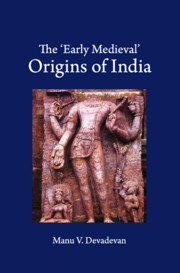Book contents
- Frontmatter
- Dedication
- Contents
- List of Tables
- List of Maps and Figures
- Acknowledgements
- 1 Introduction
- I INSTITUTIONS
- 2 State Formation and Its Structural Foundations
- 3 From the Cult of Chivalry to the Cult of Personality: The Seventh- Century Transformation in Pallava Statecraft
- 4 Changes in Land Relations and the Changing Fortunes of the Cēra State
- 5 Temple and Territory in the Puri Jagannātha Imaginaire
- II IDEAS
- 6 Svayaṃbuddha's Predilections: The Epistemologies of Time and Knowledge
- 7 Bhāravi and the Creation of a Literary Paradigm
- 8 Knowing and Being: The Semantic Universe of the Kūḍiyāṭṭaṃ Theatre
- 9 The Invention of Zero and Its Intellectual Legacy
- III IDENTITIES
- 10 The Evolution of Vernacular Languages: A Case Study of Kannada
- 11 Religious Identities in Times of Indumauḷi's Grief
- 12 Caste, Gender, and the Landed Patriarchy
- 13 The Making of Territorial Self Consciousness (with Particular Reference to Kaliṅga)
- Bibliography
- Index
4 - Changes in Land Relations and the Changing Fortunes of the Cēra State
Published online by Cambridge University Press: 02 May 2020
- Frontmatter
- Dedication
- Contents
- List of Tables
- List of Maps and Figures
- Acknowledgements
- 1 Introduction
- I INSTITUTIONS
- 2 State Formation and Its Structural Foundations
- 3 From the Cult of Chivalry to the Cult of Personality: The Seventh- Century Transformation in Pallava Statecraft
- 4 Changes in Land Relations and the Changing Fortunes of the Cēra State
- 5 Temple and Territory in the Puri Jagannātha Imaginaire
- II IDEAS
- 6 Svayaṃbuddha's Predilections: The Epistemologies of Time and Knowledge
- 7 Bhāravi and the Creation of a Literary Paradigm
- 8 Knowing and Being: The Semantic Universe of the Kūḍiyāṭṭaṃ Theatre
- 9 The Invention of Zero and Its Intellectual Legacy
- III IDENTITIES
- 10 The Evolution of Vernacular Languages: A Case Study of Kannada
- 11 Religious Identities in Times of Indumauḷi's Grief
- 12 Caste, Gender, and the Landed Patriarchy
- 13 The Making of Territorial Self Consciousness (with Particular Reference to Kaliṅga)
- Bibliography
- Index
Summary
Our examination of the processes of state formation in India in Chapters 2 and 3 leads us to the proposition that it was the spread of landed property that enabled the rise of states in different parts of the subcontinent after the fourth century, and that the state turned out to be the agency par excellence for regulating property relations. The situation obtaining in Himachal Pradesh between the sixth and the twelfth centuries reinforces this proposition. In most parts of Himachal Pradesh, arable land suitable for grain production was not available on a scale comparable to the one in the Gangetic plains and the deltas of the east coast. This geographical constraint resulted in lower levels of agrarian expansion, weaker structuring of land relations, and lesser degrees of conflicts arising from land control. In consequence, states that evolved in Himachal Pradesh were weaker in constitution and shorn of the regalities displayed by the Gaṅgā valley and peninsular states. Land grants were few in number. As a matter of fact, only six land grant charters have survived from the six centuries between the seventh and the twelfth, or rather five charters, if we discount one of them which historians regard as spurious. Territories like Trigarta, Pārakamaṭa, and Pānthila, which arose here, never rose to the heights of a Kaliṅga, a Gūrjara, or a Karnāṭa Viṣaya.
On the other hand, there were instances where areas that were rich in agriculture showed the tendency of developing strong agrarian relations and the growth of a powerful peasantry from very early times, resulting in a preference for localized political control that was resistant to the overlordship of a state. Punjab and Haryana provide instances of this kind. No land grants were made in these regions until the end of the twelfth century. No states emerged from within these regions either, except the short-lived line of the Puṣyabhūtis that ruled for some years in the beginning of the seventh century from Sthānvīśvara (Thāṇēsār) in Haryana, before moving to Kānyakubja (Kannauj) in Uttar Pradesh. The Veṅgi region of Andhra is another case in point. It never produced a state from within. A lateral line of the Caḷukyas of Bādāmi was installed there in the early seventh century.
- Type
- Chapter
- Information
- The ‘Early Medieval' Origins of India , pp. 118 - 150Publisher: Cambridge University PressPrint publication year: 2020



